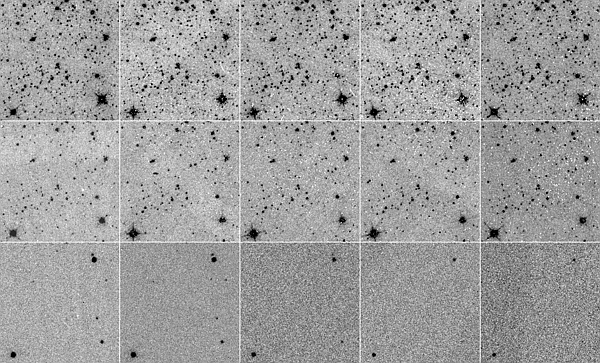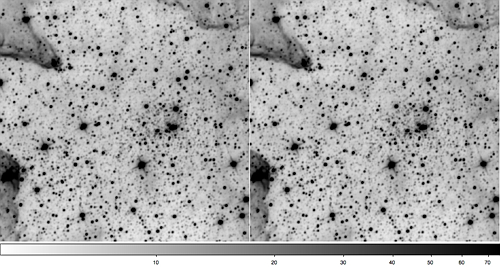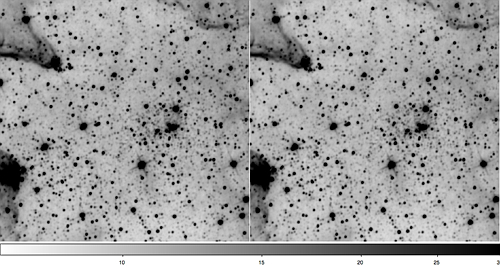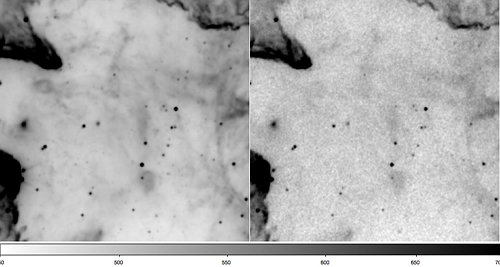


VII. 3-Band Cryo Data Release
1. Introduction
NASA's Wide-field Infrared Survey
Explorer (WISE;
Wright et al.
2010) mapped the sky at 3.4, 4.6, 12, and 22 μm (W1, W2, W3, W4) in 2010
with an angular resolution of 6.1", 6.4", 6.5", & 12.0" in the four bands.
During the full cryogenic survey phase, 7 January 2010 to 6 August 2010,
when the detectors and telescope were cooled by solid hydrogen in both
inner and outer cryogen tanks,
WISE achieved 5σ point source sensitivities better than 0.08, 0.11, 1
and 6 mJy in unconfused regions on the ecliptic in the four bands.
The sky was covered 1.2 times during this period, and the data acquired were
used to construct the products for the March 2012
WISE All-Sky Data
Release.
The WISE 3-Band Cryo survey phase began on 6 August 2010
following the exhaustion of frozen hydrogen in the payload's outer cryogen
tank. WISE scanned approximately 30% of the sky over the next 54 days
while the focal planes were cooled by hydrogen ice in the
inner cryogen tank. The
telescope warmed from the 12 K
maintained during the main mission to 45 K. Imaging data
in the 3.4, 4.6 and 12 μm bands were acquired, but elevated
thermal emission from the telescope prevented useful data from
being collected in the 22 μm band. As illustrated in
Figures 1 and 2, the 3-Band Cryo
3.4 and 4.6 μm band measurements are nearly as sensitive as those in the
full cryogenic survey, but the
increasing temperature and reduced exposure times
of the 12 μm measurements result in significantly lower sensitivity.
The WISE 3-Band Cryo Data Release incorporates data taken
between August 6 and September 29, 2010. Release data products include
an Atlas of 5,649 match-filtered, calibrated
and coadded image sets, a Source Working
Database containing positions and 3-band photometry for over 261 million
sources detected on the Atlas Images, and this Explanatory Supplement
that describes the format content, characteristics and cautionary notes
for the 3-Band Cryo Release products. The Release products were
generated through second-pass
processing using the WISE Science Data System
that benefited from improvements to calibration, processing
parameters and algorithms that were made to produce the WISE
All-Sky Data Release.
Because of the dynamic characteristics of the WISE telescope and detectors
during the 3-Band Cryo mission phase, and because these data did not
receive the same level of scrutiny as those from the full cryogenic survey,
the 3-Band Cryo products should be used with some care. You are strongly
encouraged to review the Cautionary Notes for
the WISE 3-Band Cryo Release data products to best utilize them in your
research.
The WISE
All-Sky Data Release remains the best compendium of sources
of mid-infrared emission over the entire sky. Because the 3-Band Cryo
Release data provide independent, second epoch measurements for 30% of the sky,
they are best used as a resource to learn more about objects found in the
All-Sky Release Atlas and Catalog. The 3-Band Cryo
Source Working Database can be used to test for proper motion and flux
variability of All-Sky Catalog sources. The reliability of faint sources
can be verified if they appear in the 3-Band Cryo Images, particularly in
the W1 and W2 bands where sensitivity is similar in both mission phases.
Finally, the 3-Band Cryo Images and Database can provide information
in regions that have low coverage
in the All-Sky Release products.
| |
3/24/2010 |
8/8/2010 |
8/14/2010 |
8/20/2010 |
9/18/2010 |
| W1 |
 |
| W2 |
|---|
| W3 |
|---|
| Figure 1 - Montage comparing 12'x12' sections of
Single-exposure images covering the same field near the south ecliptic pole
taken during the full cryogenic and 3-Band Cryo survey phases. The
top, middle and bottom rows show W1, W2 and W3 images, respectively.
The first column shows images taken on 24 March 2010 UTC during the full
cryogenic survey phase. Columns two through five show 3-Band Cryo survey
phase images taken on 8 August, 14 August, 20 August and 18 September 2010 UTC
when the W3 exposure times were 8.8 sec,
4.4 sec, 2.2 sec and 1.1 sec, respectively. The W1 and W2 exposure times
are 7.7 sec for all survey phases. |
| |
All-Sky |
3-Band Cryo |
| W1 |
 |
| W2 |
 |
| W3 |
 |
| Figure 2 - Comparison of Atlas Images from
the All-Sky Release (left) and 3-Band Cryo Release
(right) of the central 12'x12' region of Tile 0450p605
that contains the core of the IC 1848 star formation region.
The frame depth-of-coverage is similar in both survey phases. All of
the W3 frames that were coadded to make the 3-Band Cryo W3
Atlas Image were taken with 1.1 sec exposure times.
|
Last Updated: 2012 July 24









